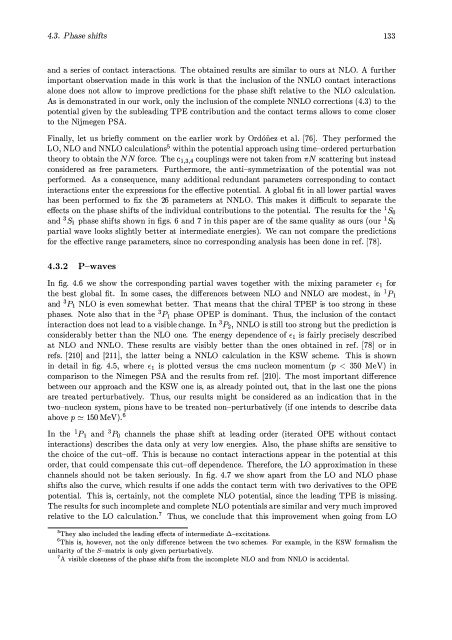The Nucleon-Nucleon Interaction in a Chiral Effective Field Theory
The Nucleon-Nucleon Interaction in a Chiral Effective Field Theory
The Nucleon-Nucleon Interaction in a Chiral Effective Field Theory
You also want an ePaper? Increase the reach of your titles
YUMPU automatically turns print PDFs into web optimized ePapers that Google loves.
4.3. Phase shifts 133<br />
and a series of contact <strong>in</strong>teractions. <strong>The</strong> obta<strong>in</strong>ed results are similar to ours at NLO. A furt her<br />
important observation made <strong>in</strong> this work is that the <strong>in</strong>clusion of the NNLO contact <strong>in</strong>teractions<br />
alone does not allow to improve predictions for the phase shift relative to the NLO calculation.<br />
As is demonstrated <strong>in</strong> our work, only the <strong>in</strong>clusion of the complete NNLO corrections (4.3) to the<br />
potential given by the sublead<strong>in</strong>g TPE contribution and the contact terms allows to come closer<br />
to the Nijmegen PSA.<br />
F<strong>in</strong>ally, let us briefly comment on the earlier work by Ord6nez et al. [76J. <strong>The</strong>y performed the<br />
LO, NLO and NNLO calculations5 with<strong>in</strong> the potential approach us<strong>in</strong>g time-ordered perturbation<br />
theory to obta<strong>in</strong> the N N force. <strong>The</strong> Cl, 3 ,4 coupl<strong>in</strong>gs were not taken from 1f N scatter<strong>in</strong>g but <strong>in</strong>stead<br />
considered as free parameters. Furthermore, the anti-symmetrization of the potential was not<br />
performed. As a consequence, many additional redundant parameters correspond<strong>in</strong>g to contact<br />
<strong>in</strong>teractions enter the expressions for the effective potential. A global fit <strong>in</strong> all lower partial waves<br />
has been performed to fix the 26 parameters at NNLO. This makes it difficult to separate the<br />
effects on the phase shifts of the <strong>in</strong>dividual contributions to the potential. <strong>The</strong> results for the 1 So<br />
and 3 SI phase shifts shown <strong>in</strong> figs. 6 and 7 <strong>in</strong> this paper are of the same quality as ours (our 1 So<br />
partial wave looks slightly better at <strong>in</strong>termediate energies). We can not compare the predictions<br />
for the effective range parameters, s<strong>in</strong>ce no correspond<strong>in</strong>g analysis has been done <strong>in</strong> ref. [78J.<br />
4.3.2 P-waves<br />
In fig. 4.6 we show the correspond<strong>in</strong>g partial waves together with the mix<strong>in</strong>g parameter EI for<br />
the best global fit. In some cases, the differences between NLO and NNLO are modest, <strong>in</strong> 1 PI<br />
and 3 PI NLO is even somewhat bett er. That means that the chiral TPEP is too strong <strong>in</strong> these<br />
phases. Note also that <strong>in</strong> the 3 PI phase OPEP is dom<strong>in</strong>ant. Thus, the <strong>in</strong>clusion of the contact<br />
<strong>in</strong>teraction does not lead to a visible change. In 3 P2, NNLO is still too strong but the prediction is<br />
considerably better than the NLO one. <strong>The</strong> energy dependence of EI is fairly precisely described<br />
at NLO and NNLO. <strong>The</strong>se results are visibly better than the ones obta<strong>in</strong>ed <strong>in</strong> ref. [78J or <strong>in</strong><br />
refs. [210J and [211], the latter be<strong>in</strong>g a NNLO calculation <strong>in</strong> the KSW scheme. This is shown<br />
<strong>in</strong> detail <strong>in</strong> fig. 4.5, where EI is plotted versus the cms nucleon moment um (p < 350 MeV) <strong>in</strong><br />
comparison to the Nimegen PSA and the results from ref. [210J. <strong>The</strong> most important difference<br />
between our approach and the KSW one is, as already po<strong>in</strong>ted out, that <strong>in</strong> the last one the pions<br />
are treated perturbatively. Thus, our results might be considered as an <strong>in</strong>dication that <strong>in</strong> the<br />
two-nucleon system, pions have to be treated non-perturbatively (if one <strong>in</strong>tends to describe data<br />
above p� 150 MeV).6<br />
In the 1 PI and 3 Po channels the phase shift at lead<strong>in</strong>g order (iterated OPE without contact<br />
<strong>in</strong>teractions) describes the data only at very low energies. Also, the phase shifts are sensitive to<br />
the choice of the cut-off. This is because no contact <strong>in</strong>teractions appear <strong>in</strong> the potential at this<br />
order, that could compensate this cut-off dependence. <strong>The</strong>refore, the LO approximation <strong>in</strong> these<br />
channels should not be taken seriously. In fig. 4.7 we show apart from the LO and NLO phase<br />
shifts also the curve, which results if one adds the contact term with two derivatives to the OPE<br />
potential. This is, certa<strong>in</strong>ly, not the complete NLO potential, s<strong>in</strong>ce the lead<strong>in</strong>g TPE is miss<strong>in</strong>g.<br />
<strong>The</strong> results for such <strong>in</strong>complete and complete NLO potentials are similar and very much improved<br />
relative to the LO calculation.7 Thus, we conclude that this improvement when go<strong>in</strong>g from LO<br />
5 <strong>The</strong>y also <strong>in</strong>cluded the lead<strong>in</strong>g effects of <strong>in</strong>termediate D.-excitations.<br />
6 This is, however, not the only difference between the two schemes. For example, <strong>in</strong> the KSW formalism the<br />
unitarity of the S-matrix is only given perturbatively.<br />
7 A visible closeness of the phase shifts from the <strong>in</strong>complete NLO and from NNLO is accidental.












